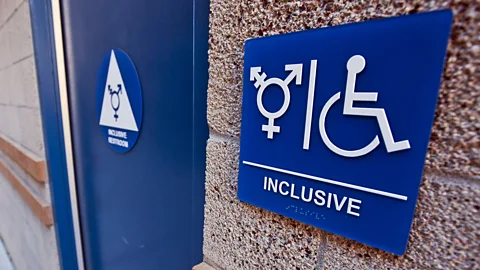Transgender, at the office
 Mladen Antonov/Getty
Mladen Antonov/GettyWhen Renee McLaughlin transitioned from a man to a woman two years ago, she figured she might have to resign from her post at health insurer, Cigna, before completing her physical transformation. She held a high-level position as a medical director and feared clients might refuse to continue working with her.
But with encouragement from fellow employees and human resources executives, Dr McLaughlin kept her job — and recently received a promotion.
Careful planning proved critical to gaining acceptance and support for her new identity. In the six-month period before Dr McLaughlin took a leave for facial feminisation surgery and breast augmentation, she and members of the company’s “transition team” discussed the gender change with the many employees she worked with, as well as key corporate and health-care clients.
In meetings, they addressed the company’s non-discrimination policy for transgender employees and discussed what people should expect after the medical leave. Some topics included Dr McLaughlin’s name change from Robert to Renee, her switch from men’s suits to dresses and heels — and her continued strong work performance.
“Everything was highly orchestrated and managed just as we do with any complex project at Cigna,” said Dr McLaughlin. “Only one client with whom I had a longstanding relationship asked that another Cigna clinician take over my responsibilities.”
 Renee McLaughlin
Renee McLaughlinAlthough still rare, such stories of smoother transitions are becoming more common as a growing number of businesses strive to create a transgender-friendly culture.
Gender identity is now part of the non-discrimination policies at two-thirds of Fortune 500 companies, up from just 3% in 2002, according to the Human Rights Campaign (HRC), an advocacy group for lesbian, gay, bisexual and transgender (LGBT) Americans. In addition, one-third of Fortune 500 companies offer trans-inclusive healthcare benefits, compared to zero in 2002.
“We have received more calls over the last 18 months from companies that have the right policies and benefits in place, but now want advice on how to educate their workforce and humanise the gender transition for one of their employees,” said Deena Fidas, director of HRC’s workplace equality program. “Rather than give a sterile inclusion talk, they want to elicit more understanding and compassion.”
A peak moment?
LGBT advocacy groups consider this a peak moment for transgender individuals. US Olympic star Bruce Jenner’s transition to Caitlyn Jenner has received worldwide media attention. Laverne Cox became the first openly transgender actress to receive an Emmy Award nomination and the first transgender individual to have a wax figure at Madame Tussauds, in San Francisco. And US President Barack Obama has appointed several transgender individuals to government posts.
 Arun Nevader/Getty Images
Arun Nevader/Getty ImagesThe US federal government is throwing its weight behind the rights of transgender workers. President Obama has made gender identity a protected class in the federal workforce, as well as with government contractors. Federal health benefit plan providers can no longer have blanket exclusions on transgender transition-related healthcare services. And the US Occupational Safety and Health Administration has published a guide to restroom access, urging employers to let workers use lavatories that correspond to their gender identity.
What’s more, the US Equal Employment Opportunity Commission is using a longstanding federal law protecting against discrimination based on sex to combat workplace abuse of transgender workers. (Despite repeated attempts, the US Congress has failed to enact a national law expressly prohibiting employment discrimination based on gender identity and sexual orientation.)
In Europe, more countries are recognising the human rights of the transgender community, according to the International Lesbian, Gay, Bisexual, Trans and Intersex Association. As examples, it cites Malta as the first European country to explicitly give gender identity constitutional protection from discrimination, and Denmark as the first to allow people to have their correct gender recognised without a medical diagnosis or judicial authorisation. Altogether, more than 20 European nations protect transgender workers from discrimination.
In the UK, the 2010 Equality Act “was a game changer” for transgender workers, said Stephen Whittle, a transgender man and co-founder of activist organisation Press for Change. “Until then, there were battles in many workplaces. Now, we have a sense that it’s more ordinary, that transgender individuals are part of British life.”
Still uphill
Even so, transgender employees still encounter bias and harassment from colleagues and bosses at many organisations. A survey of transgender people in the European Union countries revealed that more than a third felt discriminated against when looking for a job, and more than a quarter had experienced bias at work. Belgium had the most respondents reporting discrimination during the job search (53%), while France had the largest number encountering bias in the workplace (35%).
 Alamy
AlamyDiscrimination is getting less overt at some companies, with fewer people being fired for being transgender,” said Mara Keisling, executive director of the National Center for Transgender Equality. “But many transgender employees are still marginalised and are often kept hidden from clients and customers. They don’t get promotions — or jobs in the first place.”
The US unemployment rate for transgender people is estimated to be double that of the overall US population, according to a survey sponsored by the National Center for Transgender Equality. In addition, 44% of respondents said they were “underemployed” in jobs they weren’t suited for. Citing employment discrimination and the need to earn a living, 16% reported some experience in sex work, illegal drug sales and other underground jobs.
“Major multinational corporations have implemented critical protections and benefits at rates that far outpace lawmakers,” Fidas of the HRC said. “But we also know from all the stories of unemployment and underemployment in the transgender community that we need a lot more improvements for workplaces to be truly fair and inclusive.”
Even in the most favourable environments, changing one’s gender identity while continuing to work at the same company can be a daunting — and sometimes risky — move. “It took people time to be comfortable with my new name and to use feminine pronouns,” Dr McLaughlin of Cigna said. “But it helped that I was a proven entity, and people knew what to expect from me in my work. Some relationships have suffered, but some have improved because people recognised the courage it took for me to transition.”
In contrast, Danielle Piergallini began her transition while she was in business school at Vanderbilt University in Tennessee in the US. She entered the MBA program as Daniel, but graduated as Danielle. When she began applying for jobs, she used her new name and focused on companies with transgender-friendly policies. Occasionally in phone interviews, some recruiters thought she was a man because of her deep voice, but she detected no signs of bias.
She chose to join American Airlines as a senior analyst because of its longstanding support of the LGBT community, and turned down a slightly more lucrative offer from another company that lacked an antidiscrimination policy covering transgender employees and insurance benefits for trans-surgery.
“I think it was much easier coming into the company after the fact rather than transitioning on the job,” Piergallini said. Sometimes, though, she does get treated as a curiosity. “People may not talk about certain things with me, like planning to have children, and some of the business school students didn’t include me as much in parties,” she said. “But overall, I’ve really been lucky with the support I have received in business school and at American.”
Challenges for global companies
Global companies face special challenges because they must tailor their transgender policies and benefits to fit the local market’s laws and culture. Accenture, a consulting, technology services and outsourcing firm, prohibits disrespect or harassment on the basis of gender identity and expression in all countries, including those that offer no legal protections for transgender employees.
Other policies vary by country, however. Accenture currently provides coverage for hormone therapy, mental health counselling and transgender surgeries only in the US and Canada. In time, a company spokeswoman says, it plans to offer similar benefits in additional countries.
Gender non-specific restrooms are available in Accenture offices in Canada, Australia, India and the Philippines, and gender non-specific dress codes have been developed for Canada and the Philippines. “We’ve collapsed the traditional two columns of the dress code — but kept certain standards — so it doesn’t mean gender-neutral Star Trek uniforms” or kinky “Rocky Horror Picture Show” garb, said Denise Norris, a senior analyst at Accenture and a transgender activist.
A global transgender strategy “is about adapting to local conditions, including workplace expectations and the strength of gender stereotyping,” she said. “In cultures that don’t embrace gender diversity, Accenture’s workplace can become a haven, a safe space for our transgender employees.”
